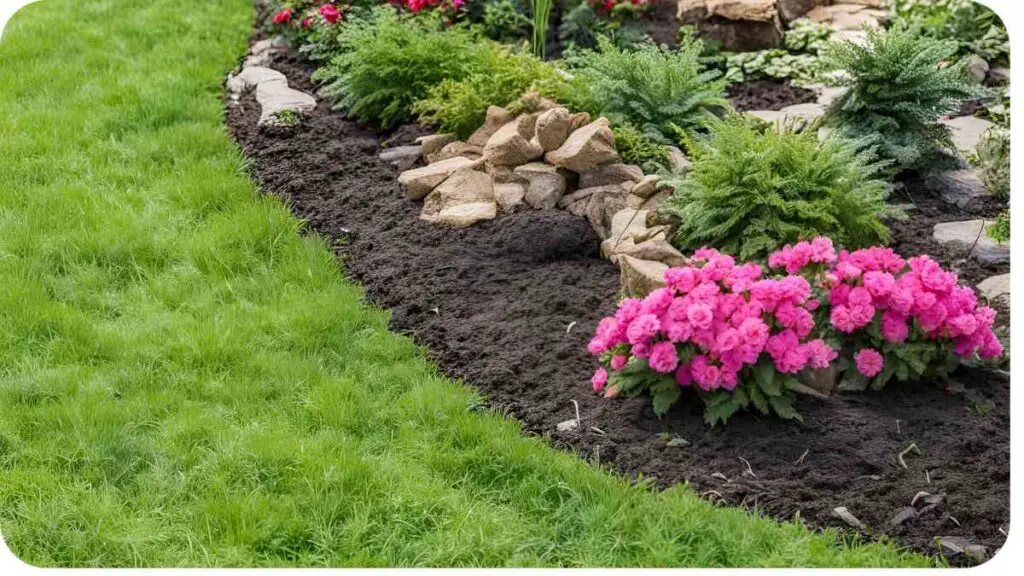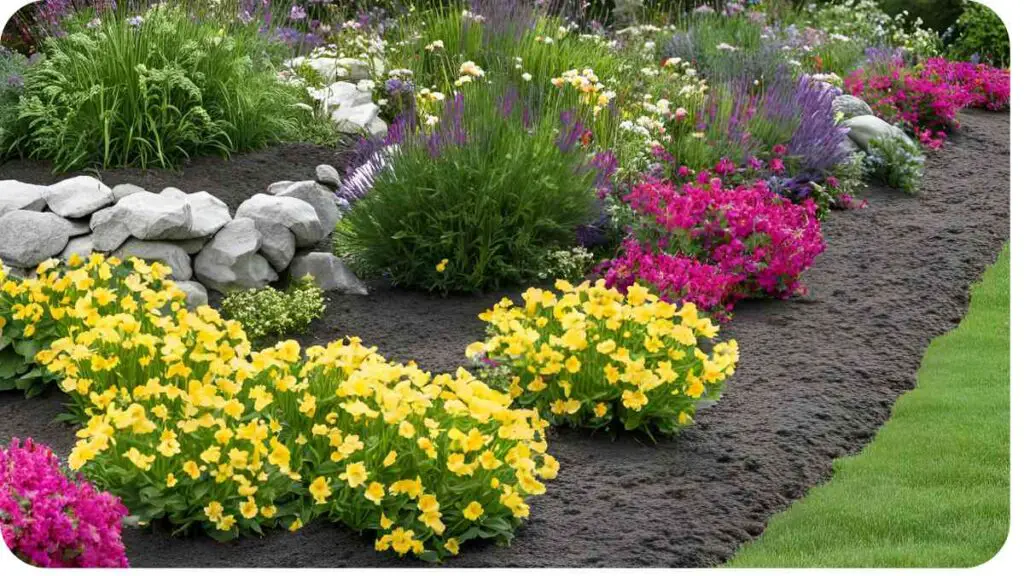When winter finally bids adieu and spring comes knocking at your door, it’s time to revive your garden beds from their chilly slumber. Cleaning flower beds after winter is a crucial task to ensure the health and beauty of your garden throughout the growing season.
In this guide, we’ll walk you through step-by-step on how to rejuvenate your flower beds and prepare them for the vibrant blooms ahead.
| Key Takeaways |
|---|
| Start cleaning your flower beds in early spring to prepare them for the growing season ahead. |
| Assess the damage and prioritize tasks based on the specific needs of your flower beds. |
| Remove debris, prune dead or damaged branches, and prepare the soil for planting. |
| Implement weed control measures to prevent weeds from competing with your flowers for nutrients and water. |
| Fertilize your flower beds to replenish nutrients and promote healthy growth. |
| Mulch your flower beds to conserve moisture, suppress weeds, and regulate soil temperature. |
| Choose plants that are well-suited to your climate and soil conditions when planting new flowers. |
| Protect against pests by encouraging natural predators and monitoring plants for signs of infestation. |
| Establish a consistent watering routine to ensure your plants receive adequate hydration throughout the growing season. |
| Use the right tools for the job and avoid common mistakes such as over-fertilizing and neglecting weed control. |
| Explore further reading resources for additional tips and advice on cleaning flower beds after winter. |
2. Assessing the Damage

Before diving into the cleaning process, take a moment to assess the condition of your flower beds. Look for signs of winter damage such as dead plants, broken branches, compacted soil, and debris buildup. Make note of any areas that require special attention so you can prioritize your efforts effectively.
As spring arrives, knowing what to do with flower beds is crucial. Clearing debris, pruning, and fertilizing are essential steps to revive your garden after winter’s dormancy.
| Signs of Winter Damage |
|---|
| Dead plants |
| Broken branches |
| Compacted soil |
| Debris buildup |
Assessing the damage upfront will help you develop a tailored cleaning plan to address specific issues in your flower beds.
3. Removing Debris
One of the first tasks in cleaning flower beds after winter is to remove any accumulated debris. Fallen leaves, twigs, and other organic matter can harbor pests and diseases, so it’s essential to clear them out.
| Debris Removal Checklist |
|---|
| Fallen leaves |
| Twigs |
| Dead plants |
| Weeds |
Use a rake or garden fork to gently gather the debris, being careful not to disturb emerging plants or bulbs. Dispose of the debris in a compost pile or green waste bin.
4. Pruning and Trimming

After clearing away debris, it’s time to give your plants some much-needed attention. Pruning and trimming dead or damaged branches will promote healthy growth and improve the overall appearance of your flower beds.
Are pesky felines wreaking havoc in your garden? Discover effective strategies on how to keep cats out of your flower beds to maintain the beauty and health of your flowers without harming your furry friends.
| Pruning and Trimming Tips |
|---|
| Remove dead or diseased branches |
| Trim overgrown foliage to encourage new growth |
| Shape shrubs and hedges for a tidy appearance |
| Cut back perennial plants to stimulate fresh growth |
Use clean, sharp pruning shears to make clean cuts and avoid tearing the plant tissue. Remember to prune according to the specific needs of each plant species to avoid causing stress or harm.
5. Soil Preparation
Preparing the soil is essential for ensuring your flower beds have the nutrients and structure needed for optimal plant growth. Start by loosening the soil with a garden fork or tiller to improve aeration and drainage.
| Soil Preparation Steps |
|---|
| Loosen compacted soil |
| Remove weeds and debris |
| Amend soil with compost or organic matter |
| Test soil pH and adjust if necessary |
Adding compost or organic matter to the soil will enrich it with essential nutrients and improve its texture. Aim for a loamy soil consistency that is well-draining yet retains moisture.
6. Weed Control
Weeds are a common nuisance in flower beds and can quickly take over if left unchecked. Implementing a weed control strategy early in the season will save you time and effort down the road.
| Weed Control Methods |
|---|
| Hand-pulling weeds |
| Mulching to suppress weed growth |
| Using herbicides sparingly and selectively |
| Regular maintenance to prevent weed spread |
Be diligent about removing weeds by hand or using tools like a garden hoe to prevent them from competing with your flowers for nutrients and water.
7. Fertilizing
Providing your plants with the right nutrients is key to their overall health and vigor. Fertilizing your flower beds after winter will replenish the soil and give your plants the boost they need to thrive.
When rodents invade your outdoor sanctuary, it’s time to take action. Learn practical tips on how to get rid of rats in your flower beds to safeguard your plants and create a pest-free environment for your garden oasis.
| Fertilizing Guidelines |
|---|
| Choose a balanced fertilizer with equal parts nitrogen, phosphorus, and potassium |
| Apply fertilizer according to package instructions, taking care not to over-fertilize |
| Water thoroughly after fertilizing to help nutrients penetrate the soil |
| Consider using organic fertilizers for a more sustainable option |
Timing is crucial when fertilizing, so aim to do it early in the growing season when plants are actively growing and in need of nutrients.
8. Mulching
Mulching is a simple yet effective way to conserve moisture, suppress weeds, and regulate soil temperature in your flower beds. Applying a layer of mulch after cleaning will help protect your plants and enhance the overall aesthetics of your garden.
| Mulching Benefits |
|---|
| Conserves moisture |
| Suppresses weed growth |
| Regulates soil temperature |
| Improves soil fertility |
Choose a mulch material that complements your garden aesthetic and climate, such as wood chips, shredded bark, or organic compost.
9. Planting New Flowers

After preparing the soil and implementing necessary maintenance tasks, it’s time to add some color and variety to your flower beds. Selecting the right plants for your garden and properly planting them will set the stage for a beautiful display throughout the season.
Overgrown flower beds can be overwhelming, but fear not! Follow this comprehensive guide on how to get rid of flower beds in full weeds to reclaim your garden space and restore its beauty for the upcoming season.
| Planting Tips |
|---|
| Choose plants that are well-suited to your climate and soil conditions |
| Space plants according to their mature size to prevent overcrowding |
| Dig planting holes slightly larger than the root ball and backfill with soil |
| Water newly planted flowers thoroughly and monitor for signs of stress |
Consider incorporating a mix of annuals, perennials, and bulbs to create visual interest and prolong the blooming period in your garden.
10. Protecting Against Pests
As your flower beds come to life, they may attract unwanted visitors in the form of pests and diseases. Taking proactive measures to protect your plants will help safeguard their health and longevity.
| Pest Prevention Strategies |
|---|
| Encourage natural predators such as ladybugs and birds |
| Use physical barriers like row covers or netting to deter pests |
| Monitor plants regularly for signs of pest damage and treat infestations promptly |
| Practice good garden hygiene by removing debris and weeds that harbor pests |
By staying vigilant and implementing preventative measures, you can minimize the impact of pests on your flower beds and maintain a thriving garden ecosystem.
11. Watering Tips
Proper watering is essential for the health and vitality of your plants, especially during the warmer months when water requirements increase. Establishing a consistent watering routine will help prevent drought stress and ensure your flowers reach their full potential.
| Watering Best Practices |
|---|
| Water deeply and infrequently to encourage deep root growth |
| Water in the morning to reduce evaporation and minimize disease risk |
| Use a soaker hose or drip irrigation system to deliver water directly to the root zone |
| Adjust watering frequency based on weather conditions and plant needs |
Monitor soil moisture levels regularly and adjust your watering schedule as needed to maintain optimal hydration for your plants.
12. Tools You’ll Need
Having the right tools on hand will make the task of cleaning flower beds after winter much more manageable and efficient. Investing in quality gardening tools will save you time and effort in the long run and ensure professional results.
Weeds can detract from the beauty of your flower beds. Discover what kind of weed killer is safe and effective for your plants, ensuring a weed-free garden that flourishes with vibrant blooms all season long.
| Essential Garden Tools |
|---|
| Pruning shears |
| Garden rake |
| Garden fork |
| Hand trowel |
| Soil thermometer |
Keep your tools clean and well-maintained to prolong their lifespan and ensure they perform at their best when you need them most.
13. Common Mistakes to Avoid
While cleaning flower beds may seem straightforward, there are some common pitfalls that gardeners often encounter. Being aware of these mistakes will help you avoid them and achieve better results in your garden.
| Common Mistakes |
|---|
| Over-fertilizing |
| Neglecting weed control |
| Planting too deeply |
| Using the wrong mulch |
Take your time and pay attention to detail to avoid making these common mistakes that can compromise the health and beauty of your flower beds.
14. Conclusion
Cleaning flower beds after winter is a labor of love that pays off in the form of vibrant blooms and lush foliage throughout the growing season. By following the steps outlined in this guide and staying proactive with maintenance, you can ensure your garden beds are healthy, beautiful, and ready to impress.
Further Reading
For more tips and advice on cleaning flower beds after winter, check out the following resources:
- How to Clean Garden Beds: This comprehensive guide covers everything you need to know about cleaning and maintaining garden beds for a healthy and thriving garden.
- Spring Garden Clean Done Right: Learn how to tackle spring garden cleaning like a pro with this informative article, packed with expert tips and tricks.
- Spring Garden Clean-Up: Discover the essential steps for spring garden clean-up and get your garden ready for the growing season ahead.
FAQs
How soon after winter should I clean my flower beds?
Cleaning flower beds should ideally be done in early spring, once the weather begins to warm up and plants start emerging from dormancy.
Can I clean flower beds during winter?
It’s generally not recommended to clean flower beds during winter, as plants are dormant and cleaning may cause damage or disrupt their growth cycle.
Should I remove mulch when cleaning flower beds?
Removing old mulch can help prevent the buildup of pests and diseases, but it’s not always necessary. Consider whether the mulch is still effective and if it’s adding nutrients to the soil before deciding to remove it.
Do I need special tools for cleaning flower beds?
While some basic gardening tools like a rake, shovel, and pruners are helpful for cleaning flower beds, you don’t necessarily need specialized equipment. Use tools that you already have on hand and tailor your approach based on the specific needs of your garden.
How often should I clean my flower beds?
The frequency of cleaning flower beds depends on various factors such as climate, plant types, and garden maintenance practices. In general, aim to clean flower beds at least once a year in early spring to remove debris, weeds, and prepare the soil for new growth.

For 15 years, Hellen James has worked in the gardening industry as an expert and landscape designer. During her career, she has worked for a variety of businesses that specialize in landscaping and gardening from small firms to large corporations.

